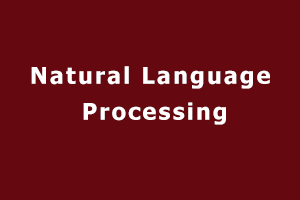Natural Language Processing, or shortly known as NLP, is broadly defined as the automatic manipulation of natural language, in the form of speech and text, by software in the way humans communicate with each other. Given the importance of this language data, we can have methods to understand and develop reason about natural language in a way as we do for other types of data. The study of natural language processing was started more than 50 years ago and emerged from the field of linguistics with the rise of computers. Natural language processing tools are important for businesses that deal with large amounts of unstructured text, in emails, survey responses, social media comments, online chats, and many other forms of data. By bringing NLP into the business, organizations can analyze data to find what’s relevant amidst the chaos, and gain valuable information that can help automate tasks and even drive business decisions.
NLP applies algorithms to understand and extract the natural language rules to convert unstructured language data into a form that machines can understand. When the text has been provided, the computer will utilize algorithms to extract meaning associated with every sentence and collect the essential data from them using the rules defined in the algorithm. A typical interaction between humans and machines using NLP could go as follows:
- A human talking to the machine
- The machine capturing the audio
- Audio to text conversion taking place
- Processing of the text’s data
- Data to audio conversion taking place
- The machine responding to the human by playing the audio file
Some of the most interesting and commonly found applications of natural language processing include:
Sentiment Analysis:
The purpose of semantic analysis is to draw dictionary meaning or exact meaning from the text. For example, in the sentence “John is great”, the speaker is talking about a person whose name is John and he is conveying the positive aspect of John. This task done by NLP to get the proper meaning of the sentence is called semantic analysis.
Chatbots & Virtual Assistants:
With the advent and rise of chatbots, we are starting to see them utilize artificial intelligence. Within the context for the right applications, NLP can pave the way for an easy to use interface to automated features and services. But more importantly, an NLP based chatbot can give the end-users a feeling that they’re having a conversation, instead of going through an already specified set of options to reach their respective goals.
Machine Translation:
Machine translation is a field of computational linguistics that makes the use of software to translate text or speech from one language(such as English) to another(such as Hindi). With a specially trained machine, machine translation can capture the context of full sentences before translating them, which provides high quality and human friendly output by retaining the layout of the text and returning the translation almost immediately.
Text Classification:
Text classification also known as text categorization or text tagging is the process of categorizing text into pre-defined groups such as informative, narrative, etc. By using NLP, text classifiers can automatically analyze text such as emails, chat conversations, websites, and social media and then assign a set of pre-defined tags or categories based on its content.
Text Summarization:
Automatic text summarization is a common problem in machine learning and NLP where Machine learning models are usually trained to understand documents and extract the useful information from the source document and combine it to make a summary based on the defined metric without making any changes to the texts. For example, Joseph and Mary rode on a donkey to attend the annual event in Jerusalem. Mary gave birth to a child named Jesus. Summary: Joseph and Mary attend the event in Jerusalem. Mary birth Jesus.
Auto-Correct:
Spelling correction is a well-known task in Natural Language Processing (NLP). Automatic spelling correction is required for many NLP applications like web search engines, sentiment analysis, text summarization, etc. Most of the autocorrect algorithms use parallel data of noisy and correct word mappings from different sources as training data for automatic spelling correction and use this training to provide suggestions for incorrect spellings accordingly.
The English language is the most widely used language as a medium of communication around the world. Having a certification for the English language can be an advantage. StudySection provides an English Certification Exam that tests English language proficiency in English grammar, reading, and writing.




